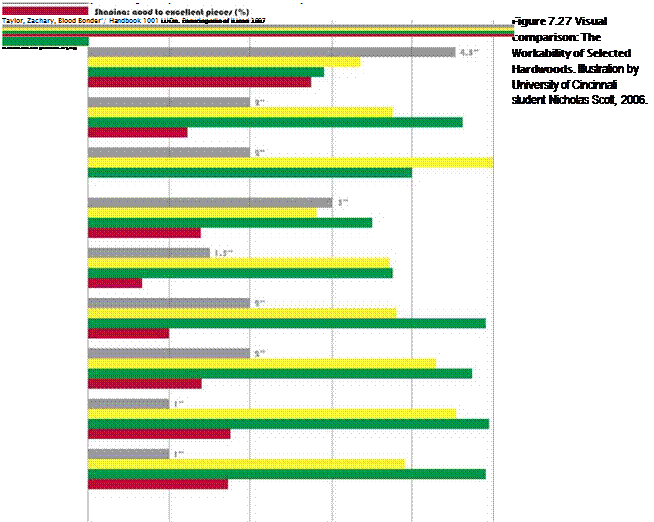Workability is the quality of a material’s response to being cut, drilled, sanded, planed, folded, or shaped. For wood, the classifications applied to the resistance in cutting and the blunting effects on tools are based on kiln-dried wood of 12 percent moisture content. Mahogany is easy to cut and carve and is an ideal choice for many wood furniture designs. Woods that have changes in their grain direction are difficult to joint and plane. Cherry, despite its beautiful grain figure, often has directional changes in its grain, making it somewhat difficult to work. Tempered glass cannot be cut or drilled after tempering. Care should be taken in etching tempered glass because this procedure can cause the tempered glass to shatter into hundreds of tiny pieces. Limestone is particularly easy to work with power tools. Marble and granite can be precisely cut, using either a water jet cutter or a computer numeric controlled (CNC) device; they can also be drilled, sanded, honed, and carved. However, marble is especially fragile along its veins and can easily break when shear forces are applied. Stainless steel and copper can be welded, but it is difficult to weld copper because the heat required can also melt the copper. In welding copper, low-temperature/ high-voltage welds are required.
Furniture components are fabricated. Designers need to consider the workability of materials as well as the assembly of their components (Figure 7.27).
 |
Other Aspects
The visual, tactile, and structural characteristics of materials can be affected by changes in temperature, moisture, and time. Most woods, especially cherry, will darken when exposed to full-spectrum sunlight (UV radiation) and air (oxidation). With a proper finish, when allowed to age naturally, cherry has enormous visual depth and a rainbow of colors. However, American black walnut will initially darken, then, slowly lighten over a period of
time. Most metals, including aluminum, copper, and bronze, will develop a protective patina on exposed surfaces that results from the natural processes of oxidation. Leather and wood expand when exposed to moisture. Paints, stains, dyes, and applied finishes can dry out, fade, and crack over time. ABS plastics significantly fade and become brittle when exposed to full-spectrum sunlight. The surface quality of most materials is always changing, and this makes repairing or refinishing older furniture such as antiques especially difficult.
MATERIALS: A TO Z
Material classifications for furniture traditionally begin with wood and continue through metal, stone, glass, polymers, and composite boards. Some think of wood as a natural material, metal as somewhat less natural, and plastic as even further removed from nature; yet, all materials are natural. Even polymers, alloys, and synthetic materials are dependent on a base of natural compounds.
The following materials are organized alphabetically to serve as a resource for furniture designers and fabricators interested in material properties. Though adhesives are technically not considered a material, we begin with them because of their importance in making furniture and the wide spectrum of their properties.



